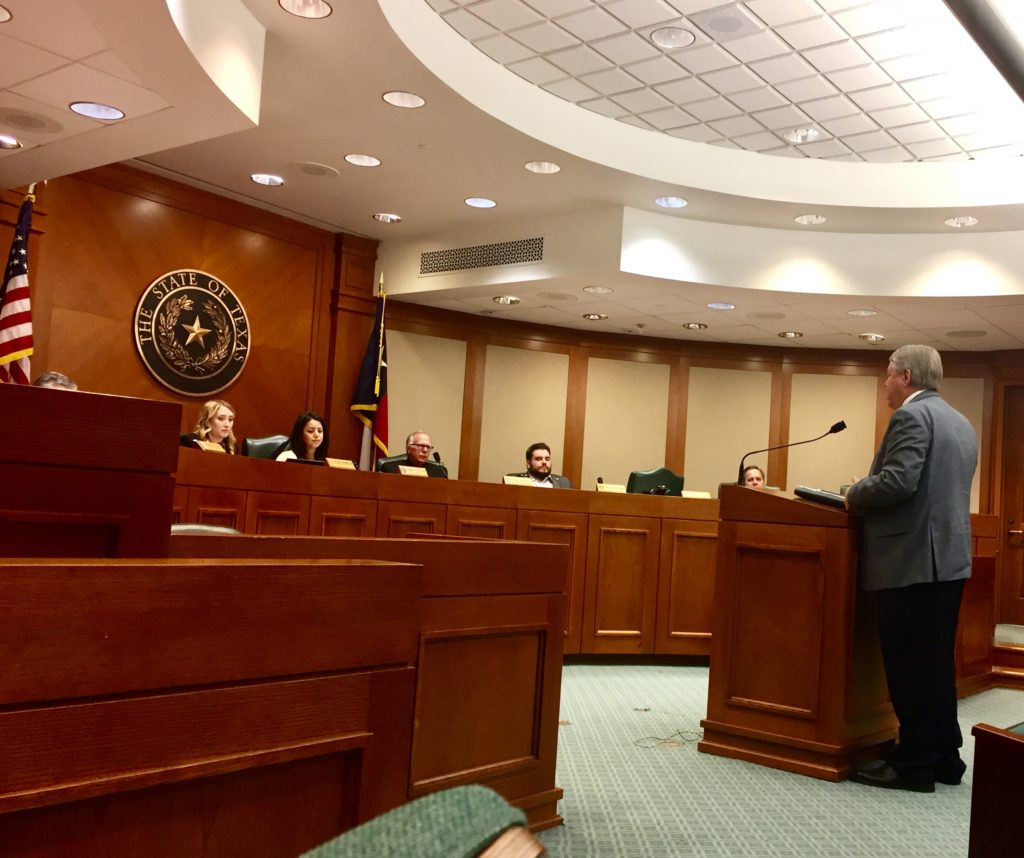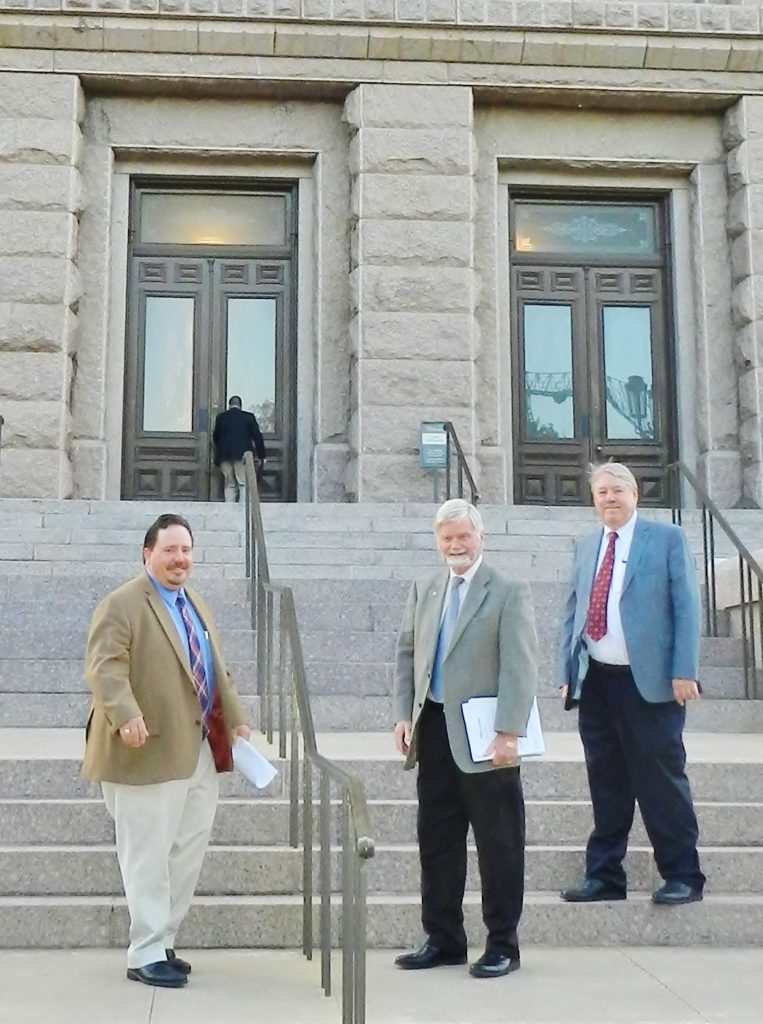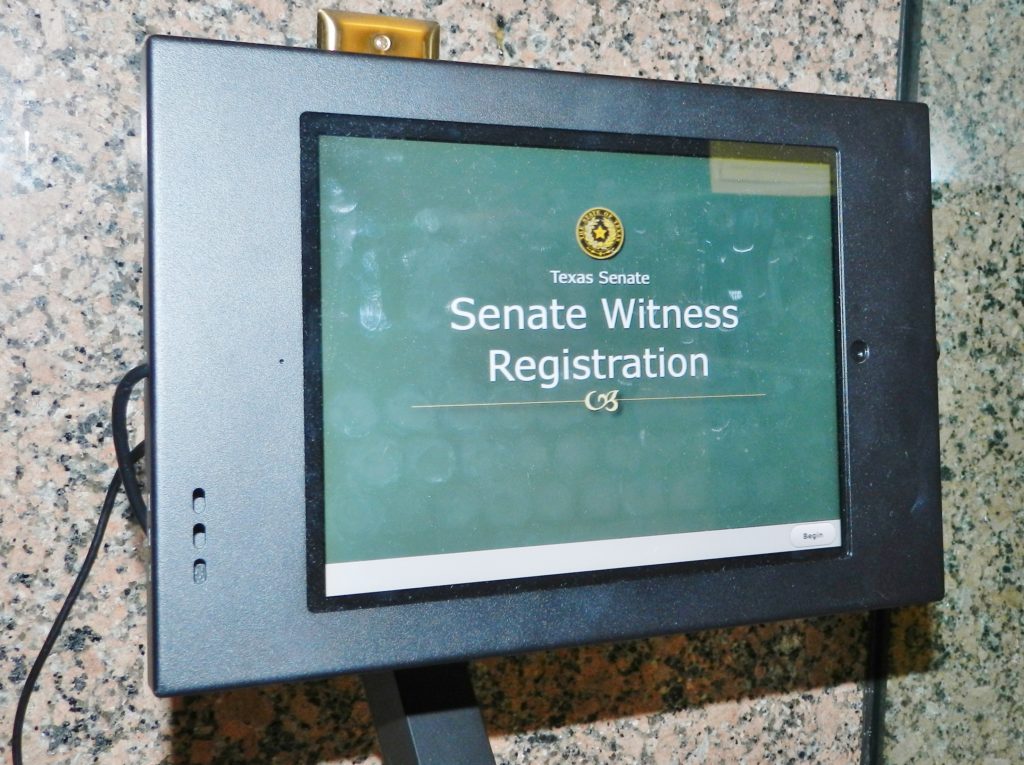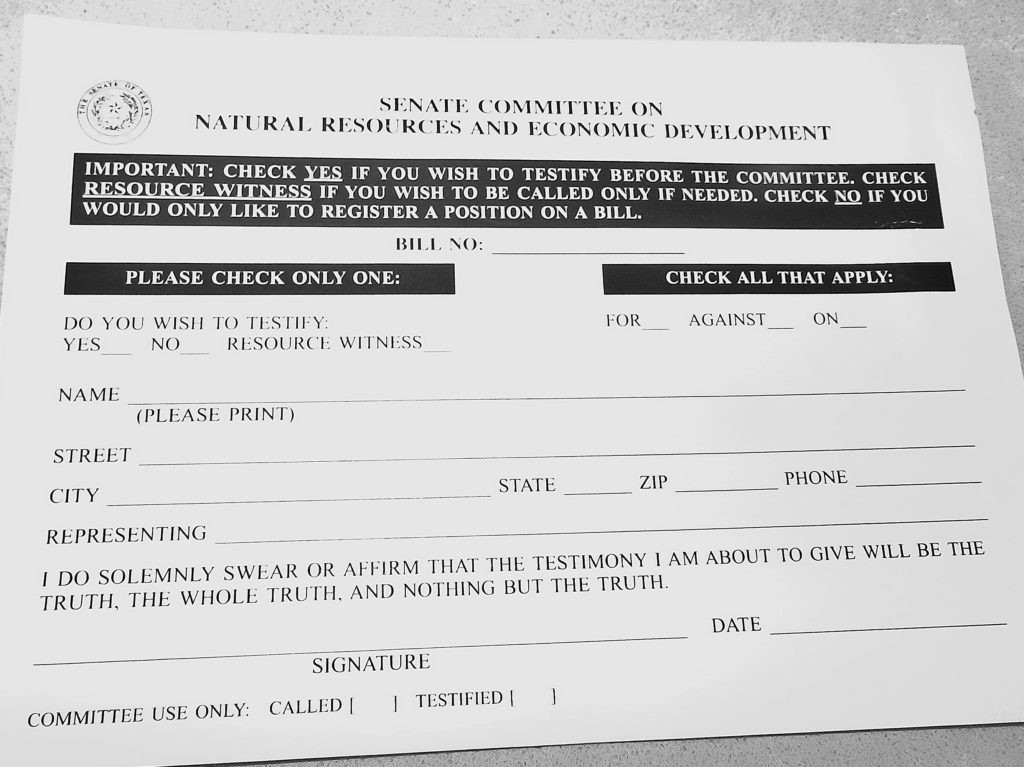County Judges and Commissioners will have the opportunity to actively exercise their role as partner to the State of Texas as the 86th Texas Legislature opens its 140-day session on Jan. 8.
The Texas Legislature meets in a regular session every two years, convening on the second Tuesday in January of every odd-numbered year. These biennial sessions are limited to 140 days. The governor is authorized to call additional special sessions as necessary, which cannot exceed 30 days. The 86th Texas Legislature is set to meet Jan. 8 through May 27. Texas legislators began pre-filing bills on Nov. 12, 2018, filing 428 bills on the first day alone.
______________________________________________________________________________
From left: TAC legislative liaison Rick Thompson, CJCAT general counsel Jim Allison, and Wichita County Judge Woody Gossom, then president of the CJCAT, make their way to the Capitol building to visit with Rep. Garnet Coleman during the 85th Legislative Session.
Barely a week after taking their oaths of office, a slate of newly elected officials will join their veteran counterparts in exercising the county’s role as partner to the State of Texas.
“In taking this oath comes the responsibility of not only upholding the laws of our great state, but also to help guide lawmakers in the process of creating new laws,” shared Anderson County Judge Robert Johnston, president of the County Judges and Commissioners Association of Texas (CJCAT) and chairman of the CJCAT Legislative Committee.
Lawmakers will be asked to consider thousands of bills throughout the 86th Session, and the CJCAT will closely monitor all proceedings to champion and protect county government. As has been pointed out by lawmakers in the past, this Association and its Legislative Committee have a reputation for approaching every session of the Texas Legislature with resolve. For example, during the past few legislative sessions, local government officials and associations such as the CJCAT voiced spirited opposition to revenue caps. Consequently, multiple regular and special sessions adjourned without imposing these restrictions and cuts, due in large part to the heightened presence and significant voice of county officials and their supporters.
If early indications ring true, County Judges and Commissioners will need to rally once more.
“Based upon current information, revenue caps and unfunded mandates will again be the issues of primary concern,” reported Jim Allison, CJCAT general counsel. “Revenue caps have been proposed for each of the past nine sessions. While there is no justification for this proposed intrusion into local decision-making, it appears that the state leadership will continue to use this issue to blame local officials for rising property taxes,” Allison continued. “While school property taxes remain the greatest cost to local taxpayers, the state continues to shift more of the cost of education onto local property taxes.”
For the first time, a proposed constitutional amendment to prohibit future unfunded mandates passed the House of Representatives last session, Allison added.
“Whether the Senate will consider this proposal to limit the unfunded cost of state legislative actions remains to be seen,” he noted.
As indicated by the recap of previous sessions below, members of Commissioners Court who become engaged in the legislative process can make a difference.
“County Judges and Commissioners need to contact their state legislators before the start of the session to inform them of the effects of proposed legislation, especially revenue caps and unfunded mandates,” Allison urged.
One educational tool available to Commissioners Court members is the slate of resolutions passed by the CJCAT at the annual conference in October 2018. These resolutions can be adapted for local consideration and submitted to legislators (see page ?).
“However, there is no substitute for a personal visit, a phone call, or a letter from a county official,” Allison emphasized.
Jim Allison offers testimony on House Bill 4117 relating to the creation of a county jail telemental health fund in April 2017.
A Look Back at the 85th Session
______________________________________________________________________________
During its 2017 regular session, the 85th Texas Legislature enacted 1,211 bills and adopted nine joint resolutions after considering 6,631 measures filed. The Legislature enacted a further 12 bills during the special session held in the summer.
______________________________________________________________________________
Perhaps the best way to paint a picture of the last legislative session is to remember what several state lawmakers said both before and after the gavel fell. In October 2016 on the opening day of the CJCAT State Conference, then-Sen. Sylvia R. Garcia, a former Harris County Commissioner, issued words of caution to some 200 officials gathered in Galveston County’s Moody Gardens.
Garcia, now a member of the U.S. Congress, told Judges and Commissioners that she “has never before seen” such a predisposition against local control among state lawmakers and urged the audience to organize, engage, and “make sure you are heard” during the 85th Legislative Session.
Officials took Garcia’s message to heart, traveling by the dozens to the Capitol when called upon to testify against proposed revenue caps and other issues that would have a negative impact on counties. Members of Commissioners Court joined first responders and other city leaders for a press conference to explain how revenue caps could affect public safety and the ability to respond to disasters. County Judges and Commissioners drove hours and then waited hours – some staying well into the night – to make sure their voices were heard.
Fast forward to the 2017 CJCAT Conference. While the 85th session was in the books and revenue caps were defeated, local officials and lawmakers who appreciate the value of local decision-making were still discussing the contentious nature of the session.
Rep. Phil Stephenson and Sen. Juan “Chuy” Hinojosa, who each received the 2017 Legislative Award from the State Association for standing strong for counties, offered their perspective.
The State of Texas has forgotten that “local control is from the bottom up,” Stephenson shared. “Somewhere along the line we lost the point.”
Hinojosa echoed Stephenson, stating emphatically that legislators “have to give flexibility and authority to local communities to govern themselves.”
84th Session County Snapshot
______________________________________________________________________________
During its 2015 regular session, the 84th Texas Legislature enacted 1,323 bills and adopted seven joint resolutions after considering 6,476 measures filed.
______________________________________________________________________________
As far as county government was concerned, the introduction of revenue caps and an early hearing date set a negative tone as some lawmakers seemed intent on restricting local government. However, members of Commissioners Courts quickly jumped in.
“You packed the room, you got on the phones, and you sent faxes and emails,” Allison declared in a conference legislative recap. “With your work and the work of a great team in Austin, we escaped this session without revenue caps.
“You’re not known around the capitol as being potted plants,” Allison continued. “You speak up. You are heard.”
Thanks to the county voice, a negative tone was not synonymous with a negative outcome; rather, the session was a success for counties in that caps were defeated and very few unfunded mandates passed, Allison summarized. In addition, during this session lawmakers did authorize additional funding for mental health, indigent defense, and courthouse preservation.
TAC legislative liaison Rick Thompson joins Wichita County Judge Woody Gossom and CJCAT general counsel Jim Allison as they work the 85th Legislative Session.
A Glance at the 83rd Session
______________________________________________________________________________
During its 2013 regular session, the 83rd Texas Legislature enacted 1,437 bills and adopted 10 joint resolutions after considering more than 6,061 measures filed. The Legislature also enacted three bills during the first called session, two bills during the second called session, and one bill during the third called session.
_________________________________________________________________________
As with every legislative session, the CJCAT came to Austin with the overall goal of playing defense.
“No additional revenue caps, no additional appraisal caps, and the defeat of most unfunded mandates were important defensive accomplishments,” reported Allison after the session. However, the Association went on the offensive as well, making plays on mental health funding and transportation.
“We had a win-win,” Allison declared.
Lawmakers earmarked some $225 million to a transportation infrastructure fund via the 83rd Texas Legislature’s Senate Bill 1747.
DeWitt County Judge Daryl L. Fowler, who traveled to and from Austin multiple times to testify before lawmakers, described it as an “unprecedented move.”
“I argued for this in Austin until I was blue in the face,” Fowler later told fellow officials at an educational conference.
In a second offensive win for the CJCAT, legislators addressed mental health via House Bill 3793.
“When the largest mental hospital in a particular area is the county jail, then we have a problem,” Allison stated emphatically. “We had two priorities – mental health and transportation. Your emails, phone calls, and personal visits are what pulled us through, resulting in one of the best sessions we’ve ever had.”
Counties and the 82nd Session
Witnesses may sign in and register support or opposition to a bill using Senate kiosks located in the Capitol Extension hallway.
______________________________________________________________________________
During its 2011 regular session, the 82nd Texas Legislature enacted 1,379 bills and adopted 11 joint resolutions after considering more than 6,000 measures filed. The Legislature also enacted eight bills during the first called session.
___________________________________________________________________________
What a difference two years makes. While the 83rd Legislature would open with a budget surplus, a daunting deficit loomed over the 82nd. Experts predicted the 2011 Legislative Session would be defined by two issues: redistricting and the state budget deficit. They were right.
“These two issues will be the driving force and determining factor in all other issues,” maintained then-CJCAT President Don R. Allred, Oldham County Judge.
Because of the $20 billion-plus deficit, “we will be bombarded with all types of unfunded mandates,” predicted then-CJCAT Second Vice President Roger Harmon, Johnson County Judge. “All I can say is to batten down the hatches and be willing to fight like we have never had to in the past.”
The 82nd Legislative Session presented a particular challenge, with lawmakers seeking deep cuts and targeting dedicated funding. For example, proposed legislation originally zeroed out the Lateral Road Fund, meaning an elimination of $14.6 million, or 100 percent of the portion of the gasoline tax dedicated to county roads by the Transportation Code. Lawmakers also put forth elimination of Overweight Truck Permit Fees valued at $15 million; the fees from these TxDOT permits are dedicated to counties for partial reimbursement for overweight truck road damage.
County Judges and County Commissioners tag-teamed one another, accompanying CJCAT officers and Allison to the Capitol to present a united message. Facing cut after cut, local elected officials showed up both literally and figuratively, sending emails and faxes, making phone calls, and putting in personal appearances to safeguard their counties, their communities, and their taxpayers.
Officials sent a firm and consistent message: Infrastructure is critical. Roads carry our emergency vehicles, school buses, employers, and employees. When it comes to roads, we are in maintenance-mode, using every penny to support and repair an outdated and over-burdened transportation system. Officials repeated the message, broken-record style; when all was said and done, both funds were fully restored.
When the 82nd Session of the Texas Legislature adjourned sine die, Commissioners Courts breathed a collective sigh of relief, as the adopted version of the state budget partially restored funding to most county programs. In addition, revenue caps and most unfunded mandates were defeated.
Comfortable shoes required! Tracking down lawmakers to offer the county perspective on legislation means a great deal of brisk walking.
Prep Work
As evidenced by these legislative recaps, involvement in the legislative process is crucial, and never more so than when there is significant turnover. The Texas Senate is composed of 31 members and the Texas House includes 150 members. There are 29 new members in the House of Representatives, and 27 of those members are freshmen, according to the office of the chief clerk of the House; the 86th Legislature will include six brand new senators, according to the office of the secretary of the Senate.
“It is our responsibility to seek out legislators – our senior partners in the state-county partnership – and educate them on our needs and responsibilities,” Allison told officials throughout last year’s CJCAT educational conference classes.
“Each of us is a vital link in having a successful year with the Legislature,” declared Wichita County Judge Woodrow W. “Woody” Gossom Jr., past president of the CJCAT and former chairman of the CJCAT Legislative Committee.
Communicating the County Message
Resolutions from the CJCAT and individual Commissioners Courts, letters, emails, telephone calls, and personal contacts are the most effective methods of informing legislators and their staff on important county issues, Allison maintained.
If your senator or representative is new, perhaps a simple review of the county and state dynamic would be helpful.
While some Senate committees offer electronic registration, others still use paper format.
State and Local
As a part of the State of Texas, the structures and duties of county government are set forth in the Texas Constitution. As an arm of the State, Texas counties can only do those actions that are specifically authorized by Texas law. Equally important, Texas counties must do those actions that are required by law, such as maintain and operate the court and jail system, conduct elections, and provide for public safety.
County Revenue – The Property Tax The taxpayer funds the majority of county government via the property tax, or ad valorem tax, which is the largest revenue source for Texas counties. About half of Texas’ 254 counties also receive funding from a local county sales tax, which when adopted allowed them to lower their property tax rate.
The county cannot levy an ad valorem tax in excess of 80 cents per $100 of property value for the county’s general fund, permanent improvement fund, road and bridge fund, and jury fund, combined. On top of the 80 cents, the county is authorized to levy a special road and bridge tax not to exceed 15 cents, and a farm-to-market/flood control tax not to exceed 30 cents; however, these taxes are subject to voter approval and must be credited to separate funds. The 80-cent general ad valorem tax and the 15-cent special road and bridge tax are authorized by Article VIII, Section 9, Texas Constitution. The 30-cent farm-to-market/flood control tax is authorized by Article VIII, Section 1-a, Texas Constitution.
Counties are also authorized by several statutes to levy certain special purpose taxes. However, these taxes when combined with the general fund tax may not total more than 80 cents per $100 assessed valuation.
Property tax rates across the state are as varied as the counties themselves, with some counties hovering in the 20- to 30-cent range, and others approaching or reaching the maximum.
In addition to the property tax and county sales tax, counties rely on fines and fees; intergovernmental revenue such as federal and state grants, contractual money, and statutory money from the State of Texas; miscellaneous revenues or transfers; and interest. However, the property tax is the most significant funding source of county government.
Sometimes, the State of Texas provides counties the necessary funds to administer state-mandated services. However, this is not always the case. When the State of Texas requires a service of a county but does not provide the necessary funding, this is called an “unfunded mandate,” whereby the county is forced to produce the necessary funding on its own. This may present a challenge to counties when working on the county budget and may impact the final property tax rate.
The property tax rate is determined after county properties are appraised.
Jim Allison and Judge Woody Gossom visit with Rep. DeWayne Burns to offer support for Burns’ House Joint Resolution 73 proposing a constitutional amendment to prohibit unfunded mandates.
As part of their commitment to the local community, Texas county governments traditionally seek to provide more than mandatory services. County governments also provide funding for authorized discretionary or optional services, such as parks, community centers, libraries, senior centers, emergency medical and family services, and county fairs. Funds also may be used to support tax increment reinvestment zones, certain non-profits, and other special programs that enhance the quality of individual lives and the community as a whole.
When all is said and done, the development of the county budget is by nature a rigorous process that requires thoughtful decisions and tough choices.
- County budgets are driven by the laws that are implemented in Austin by the Texas Legislature.
- Counties are limited to property taxes as their main revenue source.
- Taxes, for the most part, are determined by mandates put on the county by the Texas Legislature.
- Discretionary spending for local services is the first to be cut because spending for state-mandated services is just that, mandated.
- If the state would fund the laws that they adopt, then property taxes could be more closely tied to local services.
The CJCAT leadership is poised and prepared to address legislation that could further impact the ability of Commissioners Courts to fulfill state mandates and provide other needed services.
“As county-related bills are introduced, do your best to determine how these bills will impact you on the local level,” Allison urged.
As you communicate with lawmakers, be specific. Check your facts and figures, and help the state understand that what happens in Austin doesn’t stay in Austin.






















